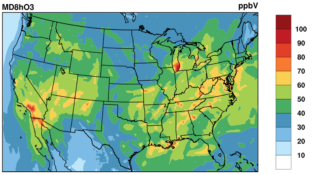LADCO uses atmospheric science to understand air pollution in our region.
LADCO uses data from surface air monitors, satellites, and computer models to investigate the drivers of air pollution in the Great Lakes region. We work with our member states to use state-of-the-art techniques and data for figuring out how to reduce air pollution in our region.

LADCO develops and applies data from computer models to enhance our understanding of air pollution in the Great Lakes region. Our computer modeling is used by the LADCO member states to develop evidence-based air pollution emissions control programs to improve air quality. We also use surface monitoring and remote sensing to gain insights into current air pollution conditions and to study historical trends in these conditions. LADCO’s air pollution science program is developed in coordination with our member states to support their policy obligations under the Clean Air Act.
LADCO also provides a forum for our member states to discuss and learn about technical and regulatory air quality issues. We convene regular meetings with our member states to discuss technical issues related to air quality planning. We also organize and facilitate training opportunities for the state air agency staff to build capacity for monitoring and controlling air pollution throughout the region.
LADCO is unique because we focus on monitoring and modeling to solely address air pollution issues in the Great Lakes region. Other organizations with similar capacity, such as universities and consultancies, work on more diverse air pollution problems. We are also unique in the space of multi-jurisdictional organizations (MJOs) in that we have a well-established, in-house air quality modeling program. Where other MJOs contract modeling work out, LADCO does the majority of our own modeling and analysis work to support our state air agencies.


